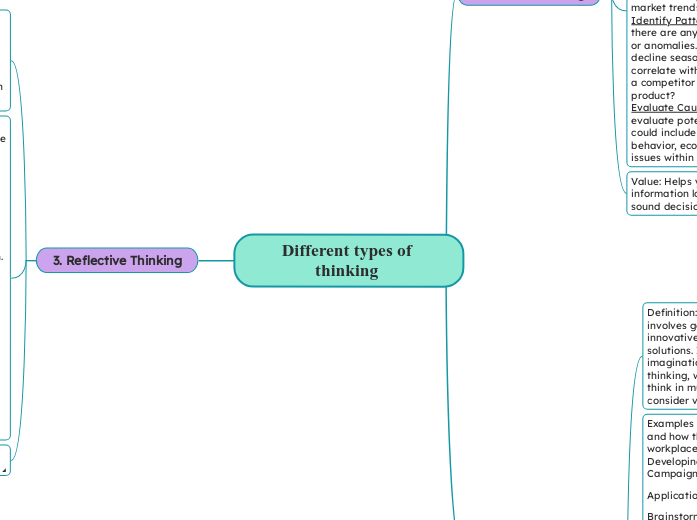Different types of thinking
1. Critical Thinking
Examples of each type of thinking and how they can be applied in the workplace: Example: Analyzing a Decline in Sales
Application:
Data Analysis: Gather data on sales performance over the past quarters. Look at various metrics such as sales volume, revenue, customer acquisition rates, and market trends.
Identify Patterns: Determine if there are any noticeable patterns or anomalies. For instance, is the decline seasonal, or does it correlate with a specific event like a competitor launching a new product?
Evaluate Causes: Critically evaluate potential causes. This could include changes in consumer behavior, economic factors, or issues within the sales team.
Value: Helps you evaluate information logically and make sound decisions.
2. Creative Thinking
Examples of each type of thinking and how they can be applied in the workplace: Example: Developing a New Marketing Campaign
Application:
Brainstorming: Hold a brainstorming session with the marketing team to generate innovative ideas for the campaign. Encourage wild and diverse ideas without immediate criticism to foster creativity.
Mind Mapping: Use mind mapping techniques to explore different themes, slogans, and visual elements. This helps in organizing thoughts and seeing connections between different ideas.
Prototyping: Create prototypes of the most promising ideas, such as mock-ups of advertisements, sample social media posts, or storyboards for video content.
Value: Enables you to generate innovative ideas and solutions.:
3. Reflective Thinking
Examples of each type of thinking and how they can be applied in the workplace: Example: Developing a New Marketing Campaign
Application:
Brainstorming: Hold a brainstorming session with the marketing team to generate innovative ideas for the campaign. Encourage wild and diverse ideas without immediate criticism to foster creativity.
Mind Mapping: Use mind mapping techniques to explore different themes, slogans, and visual elements. This helps in organizing thoughts and seeing connections between different ideas.
Prototyping: Create prototypes of the most promising ideas, such as mock-ups of advertisements, sample social media posts, or storyboards for video content.
